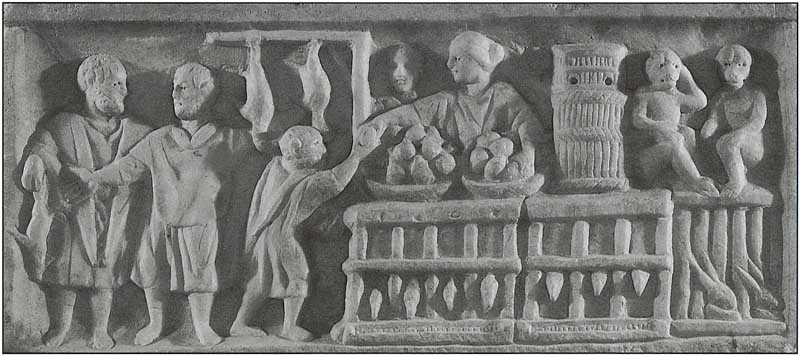

'Ancient Roman cuisine changed over the long duration of this ancient civilization. Dietary habits were affected by the influence of Greek culture, the political changes from kingdom to republic to empire, and empire's enormous expansion, which exposed Romans to many new, provincial culinary habits and cooking techniques. In the beginning the differences between social classes were not very great, but disparities developed with the empire's growth.

Traditionally in the morning, a breakfast called the ientaculum, was served at dawn, at around 11am Romans ate a small lunch, and in the evening, they consumed the cena, the main meal of the day. Due to the influence of the Greeks and the increased importation and consumption of foreign foods, the cena increased in size and diversity and was consumed in the afternoon. The vesperna, a light supper in the evening, was abandoned, and a second breakfast was introduced around noon, the prandium.
In the lower strata of society, the old routine was preserved, because it corresponded more closely to the daily rhythms of manual labor.
Originally flat, round loaves made of emmer (a cereal grain closely related to wheat) with a bit of salt were eaten; among the upper classes, eggs, cheese, and honey, along with milk and fruit were also consumed. In the Imperial period, around the beginning of the Christian era, bread made of wheat was introduced; with time, more and more wheaten foods began to replace emmer bread. The bread was sometimes dipped in wine and eaten with olives, cheese, crackers, and grapes. They also ate wild boar, beef, sausages, pork, lamb, duck, goose, chickens, small birds, fish, and shellfish.
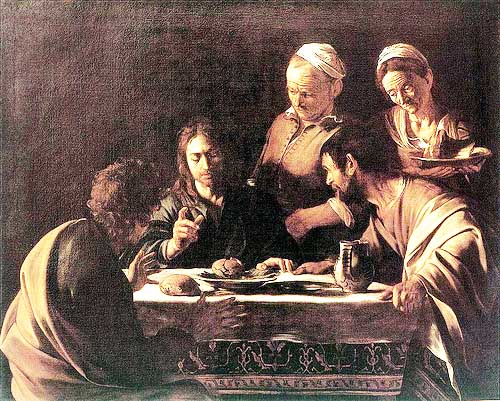
In ancient Roman culture, cena was the main meal of the day. It was a focal point of social life, along with the public baths, the frequenting of which often preceded the meal. Seating during dinner was arranged in the triclinium, three couches for reclining arranged as three sides of a square, with a small table for food in the middle of all these. Only the very wealthy would consume exotic dishes such as giraffe, ostrich, lion, and peacock.
Among the members of the upper classes, who did not engage in manual labor, it became customary to schedule all business obligations in the morning. After the prandium, the last responsibilities would be discharged, and a visit would be made to the baths. Around 2:00 pm., the cena would begin. This meal could last until late in the night, especially if guests were invited, and would often be followed by a comissatio (a round of drinks).
In the period of the kings and the early republic, but also in later periods (for the working classes), the cena essentially consisted of a kind of porridge, the puls. The simplest kind would be made from emmer, water, salt and fat. The more sophisticated kind was made with olive oil, with an accompaniment of assorted vegetables when available. The richer classes ate their puls with eggs, cheese, and honey and it was also occasionally served with meat or fish.
Over the course of the Republican period, the cena developed into 2 courses: a main course and a dessert with fruit and seafood (e.g. molluscs, shrimp). By the end of the Republic, it was usual for the meal to be served in 3 parts: 1st course (gustatio), main course (primae mensae), and dessert (secundae mensae).
From 301 BC, Greek customs started to influence the culture of higher class Romans. Growing wealth led to ever larger and more sophisticated meals. Nutritional value was not regarded as important: on the contrary, the gourmets preferred food with low food energy and nutrients. Easily digestible foods and diuretic stimulants were highly regarded.
The dinner was consumed in a special dining room, which later was to be called triclinium. Here one would lie down on a specially designed couch, the lectus triclinaris. Around the round table, the mensa, three of these lecti were arranged in the shape of a horseshoe, so that slaves could easily serve, and a maximum of three diners would recline at each lectus.
During the kingdom and early republic, the only people allowed a place on a lectus were men. By the late republic and imperial times, and especially among the aristocracy, women were permitted to recline during meals. Traditionally, women would dine sitting upright across from their husbands or fathers in chairs. More tables for the beverages stood beside the couches. All heads were oriented towards the central table, with left elbows propped on a cushion and feet at the outside of the dinnercouch. In this fashion at most nine people could dine together at one table. Further guests had to sit on chairs. Slaves normally stood.
Feet and hands were washed before the ccna. The food would be taken with the fingertips and two kinds of spoons, the larger ligula and the smaller cochlear with a needle-thin grip, which was used as a prong when eating snails and molluscs, in practice substituting for the modern fork. At the table, larger pieces would be cut up to be served on smaller plates. After each course the fingers were washed again and napkins (mappae) were customary to wipe one's mouth. Guests could also bring their own mappae to take home the leftovers from the meal or small gifts (the apophoreta). Everything that could not be eaten (e.g. bones and shells) was thrown onto the floor, whence it was swept away by a slave.
In summer, it was popular to eat outside. Many houses in Pompeii had stone couches at a particularly beautiful spot in the garden for just that purpose. People lay down to eat only on formal occasions. If the meal was routine, they ate while seated or even standing.
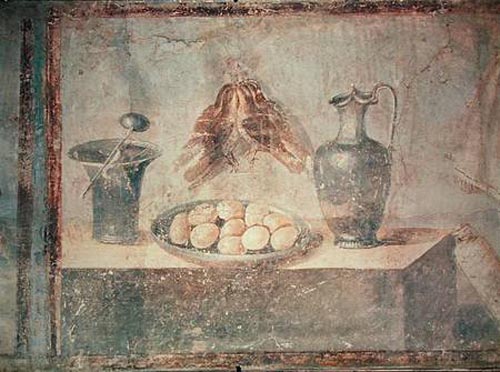
This part of the meal was called gustatio or promulsis. It generally consisted of light, appetizing dishes. The usual drink was mulsum (a mixture of wine and honey). At large feasts several starter dishes were served one after another.
The usual salad and vegetable plants were:
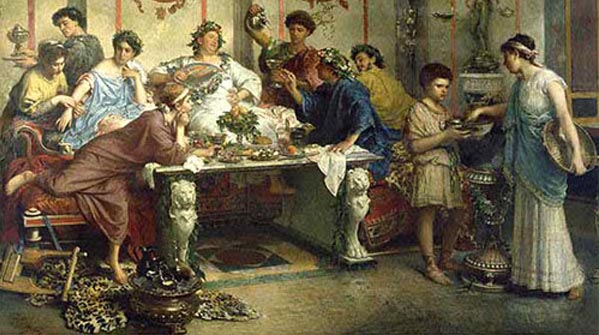
The main dish usually consisted of meat. The most common dishes were:
Pork was the most usually eaten and best liked meat. All parts of the pig were eaten, and more unusual parts like the breasts and uteruses of young sows were considered specialties. Pigs' ears were also a delicacy.
Beef was not very popular. Cattle were working animals, used for such tasks as ploughing or pulling carts, so their meat was usually very tough and had to be cooked for a long time to make it edible. Even calf meat was unpopular, with only a few recipes for it being known.
Geese were bred and sometimes fattened. The technique of force-feeding was already known, and the liver of force-fed geese was a special delicacy, as it is today. Chicken was more expensive than duck. Other birds like pavones (peacocks) and swans were eaten on special occasions. Capons and poulards (spayed hens) were considered specialties.
In 161 BCE the consul C. Fannius prohibited the consumption of poulards, though the ban was ignored. Sausages, farcimen, were made of beef and pork according to an astonishing diversity of recipes and types. Particularly widespread was the botulus, a blood sausage somewhat like black pudding, and which was sold on the streets. The most popular type of sausage was the lucanica, a short, fat, rustic pork sausage, the recipe for which is still used today.
For special effects, whole pigs were stuffed with sausages and fruit, roasted and then served on their feet. When cut, the sausages would spill from the animal like entrails. Such a pig was called a porcus Troianus ("Trojan pig"), a humorous reference to the Trojan Horse.
Hares and rabbits were bred, the former with little success, making them as much as four times more expensive than rabbits. Hares therefore were regarded as a luxury; shoulder of hare was especially favoured. Newborn rabbits or rabbit fetuses, known as laurices, were considered a delicacy.
Fish was served only in earlier periods, and it remained more expensive than simpler meat types. Breeding was attempted in freshwater and saltwater ponds, but some kinds of fish could not be fattened in captivity. Among these was the most popular, mullus, the goatfish.
At a certain time this fish was considered the epitome of luxury, above all because its scales exhibit a bright red color when it dies out of water. For this reason these fish were occasionally allowed to die slowly at the table. There even was a recipe where this would take place in garo, in the sauce. At the beginning of the Imperial era, however, this custom suddenly came to an end, which is why mullus in the feast of Trimalchio could be shown as a characteristic of the parvenu, who bores his guests with an unfashionable display of dying fish.
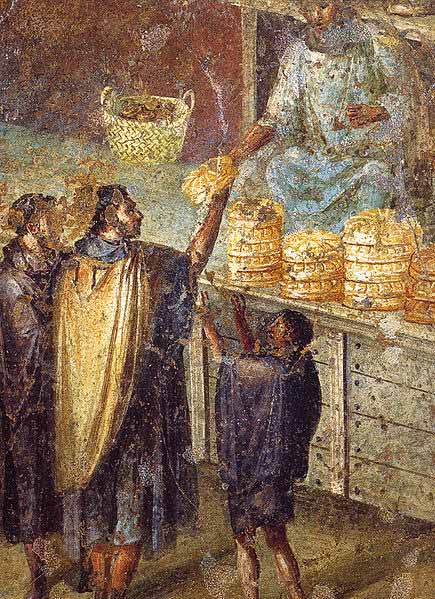
There were no side dishes or accompaniments in today's sense, although bread was consumed by all classes following the introduction of wheat. Thereafter only the poorest, with no access to an oven, had to continue eating puls. Bread, which existed in a large number of different varieties, quickly became exceptionally popular and public bakeries were established in Rome from 270 AD.
Garum, also known as liquamen, was the universal sauce added to everything. It was prepared by subjecting salted fish, in particular mackerel intestines, to a very slow thermal process. Over the course of two to three months, in an enzymatic process stimulated by heating, usually by exposure to the sun, the protein-laden fish parts decomposed almost entirely.
The resulting mass was then filtered and the liquid traded as garum, the remaining solids as alec - a kind of savory spread. Because of the smell it produced, the production of garum within the city was banned. Garum, supplied in small sealed amphorae, was used throughout the Empire and totally replaced salt as a condiment. Today similar sauces are produced in Southeast Asia, usually sold abroad under the description "fish sauce", or nam pla.
Spices, especially pepper, but hundreds of other kinds too, were imported on a large scale and used copiously. One very popular spice was silphium; however, as it could not be cultivated it finally became extinct through overcropping of the wild plant. The inherent flavors of vegetables and meat were completely masked by the heavy use of garum and other seasonings. It was considered an indication of the highest achievement in culinary art if a gourmet could tell neither by sight, nor smell, nor taste what the ingredients of a dish were.
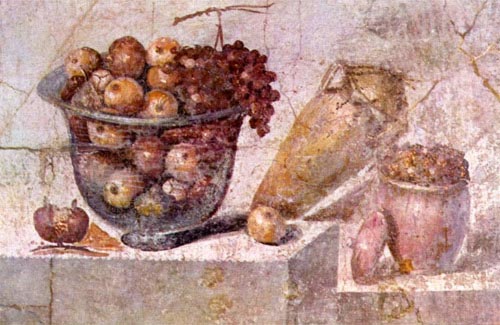
Among fruits, grapes were the most preferred. The Romans distinguished between grapes for wine-making and grapes as food. Raisins were also produced. After grapes, figs and dates played a major part and pomegranates were eaten in many varieties. Quinces, figs, dates, grapes, pomegranates, various types of apples, apricots, peaches, cherries, pears, plums, currants, strawberries, blackberries, medlars, elderberries, mulberries, azaroles, citron, raspberries, and melons were grown. Lemons were known from the 1st century AD, but not cultivated extensively. The Romans ate walnuts, hazelnuts, almonds, chestnuts and pine nuts. Roman bakers were famous for the many varieties of breads, rolls, fruit tarts, sweet buns and cakes.
Cold clams and oysters (bred on a large scale), which were originally dessert dishes, later became starters.
Cakes, made of wheat and usually soaked in honey, played a big part. Certain kinds of nuts were also available, and they were thrown at festivals much as sweets are today.
Wine was normally mixed with water immediately before drinking, since the fermentation was not controlled and the alcohol grade was high. Wine was sometimes adjusted and "improved" by its makers: instructions survive for making white wine from red and vice versa, as well as for rescuing wine that is turning to vinegar. Wine was also variously flavored.
For example, there was passum, a strong and sweet raisin wine, for which the earliest known recipe is of Carthaginian origin; mulsum, a freshly made mixture of wine and honey; and conditum, a mixture of wine, honey and spices made in advance and matured. One specific recipe, Conditum Paradoxum, is for a mixture of wine, honey, pepper, laurel, dates, mastic, and saffron, cooked and stored for later use. Another recipe called for the addition of seawater, pitch and rosin to the wine. Beer (cervesa) was known but considered vulgar. Sour wine mixed with water and herbs (posca) was a popular drink for the lower classes and a staple part of the Roman soldier's ration.
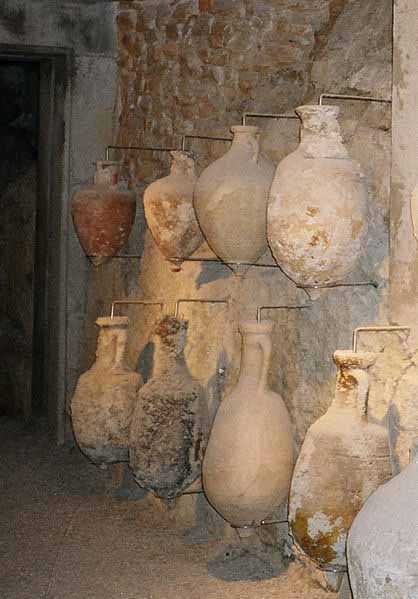
The early Roman culture viewed was sharply influenced by the ancient Greeks. Wine had religious, medicinal and societal implications that set it apart from other Roman cuisine. As Rome entered its golden age of winemaking and era of expansion, the "democratic" view of wine started to emerge in Roman culture with wine being viewed as a necessity for everyday life and not just a luxury meant to be enjoyed by a few.
In Cato's time, he believed that even slaves should have a weekly ration of over a gallon (5 liters) of wine a week. However his reasons was more for the dietary health of the slaves and maintenance of their strength rather their personal enjoyment. Should a slave become sick and unavailable to work, Cato advises cutting his rations in half to conserve wine for the workforce. It was this view that led to widespread planting in order to serve the need of all classes. Part of this was due to the changing Roman diet. In the 2nd century BC, Romans started moving away from a diet that consisted of the moist porridge and gruel to more bread-based meals. Wine became a necessity to help in eating the drier bread.
Ancient Rome played a pivotal role in the history of wine. The earliest influences of viticulture on the Italian peninsula can be traced to Ancient Greeks and Etruscans. The rise of the Roman Empire saw an increase in technology and awareness of winemaking which spread to all parts of the empire. The influence of the Romans has had a profound effect of the histories of today's major winemaking regions of France, Germany, Italy, Portugal and Spain. In the hands of the Romans, wine became "democratic" and available to all, from the lowly slave to the simple peasant to the aristocrat.
The Romans' belief that wine was a daily necessity of life promoted its widespread availability among all classes. This led to the desire to spread viticulture and wine production to every part of the Roman empire, to ensure steady supplies for Roman soldiers and colonists. Economics also came into play, as Roman merchants saw opportunities for trade with native tribes such as those from Gaul and Germania, bringing Roman influences to these regions before the arrival of the Roman military. The works of Roman writers - most notably Cato, Columella, Horace, Palladius, Pliny, Varro and Virgil - give insights on the role of wine in Roman culture and contemporary understanding of winemaking and viticultural practices. Many of the techniques and principles first developed in Roman times can be found in modern winemaking.
Wild grapevines have grown on the Italian peninsula since prehistory and historians have not been able to pinpoint the exact moment in time when domestic viticulture and winemaking first occurred. It is possible that the Mycenaean had some influences with early Greek settlements in southern Italy but the earliest recorded evidence of Greek influence was in 800 BC. Viticulture was widely entrenched in Etruscan civilization which was centered around the modern winemaking region of Tuscany. The Ancient Greeks saw wine as a staple of domestic life as well as a viable economic trade commodity. Throughout the Greek world, settlements were encouraged to plant vineyards for local use and trade with the Greek city states. Southern Italy, with its abundance of indigenous vines, was an ideal location for wine production and was known by the Greeks as Oenotria ("land of vines").
Rome grew from a collection of settlements to a kingdom and then republic, the culture of Roman winemaking was influenced by the skills and techniques of the regions that were conquered and became part of the Roman Empire. The Greek settlements of southern Italy were completely under Roman control by 270 BC. The Etruscans, who already had established trade routes into Gaul, were completely conquered by the 1st century BC.
The Punic Wars with Carthage had a particularly marked effect on Roman viticulture. In addition to broadening the cultural horizons of the Roman citizenry, they also introduced them to the advanced viticultural techniques of the Carthaginians in particular the work of Mago. When the libraries of Carthage were ransacked and burned, one of the few Carthaginian works to survive was the 26 volumes of Mago's work which was translated into Latin and Greek in 146 BC. Mago's work was extensively quoted in the influential Roman works by Pliny, Columella, Varro and Gargilius Martialis.
The work of the classical Roman writers - most notably Cato, Columella, Horace, Palladius, Pliny, Varro and Virgil - shed light on the role of wine in Roman culture as well as contemporary winemaking and viticultural practices. Some of these techniques have influences that can be seen in modern winemaking today. These include consideration of climate and landscape in choose which grape variety to plant, the benefits of different trellising and vine training systems, the effects of pruning and yields on the quality of wine, as well as winemaking techniques like sur lie aging after fermentation and the importance of cleanliness throughout the winemaking process to avoid contamination, impurities and spoilage.
Spicy wine: New study reveals ancient Romans may have had peculiar tastes PhysOrg - January 24, 2024
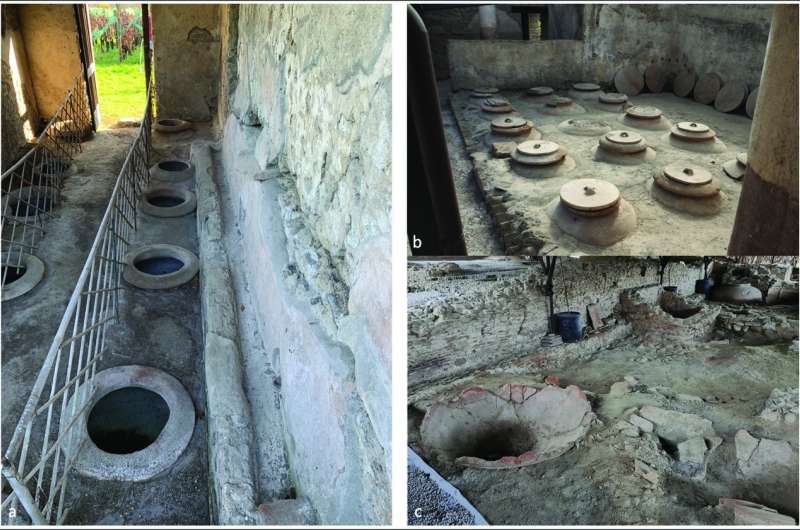
It's no secret that the ancient Romans were lovers of wine. So gripped by the grape were they, that they even worshiped a god Bacchus - devoted to wine and merriment. But, little is known about what their wine actually tasted like. Was it bitter or sweet? Fruity or earthy? According to a pioneering new study, it was rather spicy and smelled like toast. As a result of their winemaking process - and the addition of natural yeasts - the wine would have taken on a "slightly spicy" taste and given off the aroma of "toasted bread, apples, roasted walnuts and curry," researchers said.
Roman-era wine shop, possibly destroyed in an earthquake, discovered in Greece Live Science - January 24, 2024

Archaeologists in Greece have discovered a 1,600-year-old wine shop that was destroyed and abandoned after a "sudden event," possibly an earthquake or building collapse, left broken vessels and 60 coins scattered on the floor, according to new research. The shop operated at a time when the Roman Empire controlled the region. It was found in the ancient city of Sikyon (also spelled Sicyon), which is located on the northern coast of the Peloponnese in southern Greece. Within the wine shop, archaeologists found the scattered coins, as well as the remains of marble tabletops and vessels made of bronze, glass and ceramic.